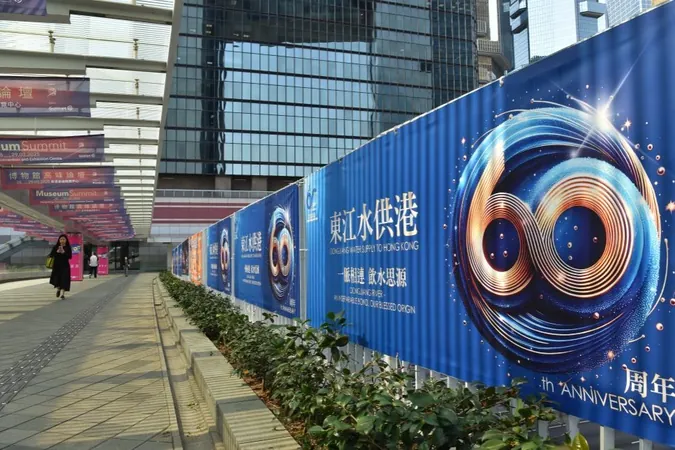
Mainland-Hong Kong Water Supply Project: The Lifeline that Transformed a Parched Metropolis
2025-03-26
Author: Jessica Wong
The Lifeline that Transformed a Parched Metropolis
HONG KONG — As part of the 60th anniversary celebrations of the transformational Dongjiang-Shenzhen Water Supply Project, Hong Kong is witnessing a wave of activities including vibrant social media challenges, exhibitions, and community events that celebrate this engineering marvel which provides a staggering 80 percent of the city’s fresh water.
Initiated back in February 1964, the project diverts water from the Dongjiang River in Jiangxi province, flowing into the bustling Pearl River Delta in Guangdong province. Its impressive 83-kilometer network of pipelines channels water from Dongguan City straight into Hong Kong after passing through the Shenzhen Reservoir.
William Ko Chan-gock, the former director of water supplies for the Hong Kong Special Administrative Region (HKSAR) government, remarked, “Hong Kong wouldn't have come this far had it not been for the water from the Dongjiang River.” This sentiment is echoed across the city, highlighting just how crucial this water source has been for urban development and stability.
Originally spurred by a devastating drought in 1963 that left Hong Kong parched, the project took just a year to build. It officially began operations on March 1, 1965, effectively ending the city's water scarcity crisis. Since its inception, there have been four major upgrades, boosting supply capacity from a modest 68 million cubic meters in the 1960s to an astounding over 2.4 billion cubic meters today. As of March 12, the project has delivered more than 30 billion cubic meters of clean water to the metropolis, significantly contributing to its rise as a leading international financial, trade, and shipping hub.
Roger Wong Yan-lok, the current director of water supplies, emphasized the project’s importance, stating, “Hong Kong's prosperity and development depend on the lifeblood that is the water diverted from the Dongjiang River.” This water is not only vital for the economy but is also crucial for sustaining public health and environmental stability in the region.
To ensure the purity of the water source, Anyuan County in Jiangxi has implemented stringent measures, including a ban on deforestation, fishing, and mining activities. Over the years, the county has shut down more than 160 polluting factories, maintaining an impressive afforestation rate of 83 percent. Local heroes like Gong Longshou, a dedicated ranger, has personally monitored over 400,000 mu (about 26,667 hectares) of forest for 46 years, wearing out over 100 pairs of shoes in his quest to combat fire and pollution.
The project was no small feat, with thousands of construction workers enduring harsh weather including rainstorms and typhoons to ensure its completion within a year. This massive undertaking has instilled a sense of appreciation among the younger generation, with students from Hong Kong expressing newfound respect for the efforts invested by mainland provinces during a recent tour to Dongguan and Shenzhen.
As the project enters its sixth decade, it embraces a digital transformation. The Water Supplies Department has established a Digital Water Office to modernize operations, incorporating drones, robots, and unmanned ships into its infrastructure. This innovative approach aims to enhance the quality and eco-friendliness of water supply services, demonstrating a commitment to sustainable management.
Kenneth Fok Kai-kong, a member of the Legislative Council of the HKSAR, reflected on the project’s significance, noting, “It reflects the motherland's unwavering support for Hong Kong's development.” This sentiment resonates deeply with the various residents who are celebrating this critical resource.
Looking ahead, the Water Supplies Department has promised a series of additional events to mark the 60th anniversary, including a grand commemorative ceremony, an international summit for water pioneers, and an installation art exhibition. As Hong Kong continues to thrive with the water flowing from the Dongjiang River, the legacy of the project stands testament to collaboration, resilience, and the critical importance of safeguarding our natural resources.



 Brasil (PT)
Brasil (PT)
 Canada (EN)
Canada (EN)
 Chile (ES)
Chile (ES)
 Česko (CS)
Česko (CS)
 대한민국 (KO)
대한민국 (KO)
 España (ES)
España (ES)
 France (FR)
France (FR)
 Hong Kong (EN)
Hong Kong (EN)
 Italia (IT)
Italia (IT)
 日本 (JA)
日本 (JA)
 Magyarország (HU)
Magyarország (HU)
 Norge (NO)
Norge (NO)
 Polska (PL)
Polska (PL)
 Schweiz (DE)
Schweiz (DE)
 Singapore (EN)
Singapore (EN)
 Sverige (SV)
Sverige (SV)
 Suomi (FI)
Suomi (FI)
 Türkiye (TR)
Türkiye (TR)
 الإمارات العربية المتحدة (AR)
الإمارات العربية المتحدة (AR)